Whipped up in under 10 minutes, this healthy and flavoursome Korean steam eggplant side dish is calling your name! Gaji namul is a popular Korean side dish, and it’s easy to see why. Lip smackingly delicious!
Jump to:
Why You’ll Love This Side Dish
Steaming eggplant is one of the quickest and healthiest ways to enjoy this nightshade fruit. They are easy to find all year round and are also extremely budget friendly.
As with most Korean side dishes, there is a mixed sauce or seasoning component, which is then folded through the vegetable. They are always so flavoursome and unobtrusive as it forms 1 of the many different Korean side dishes you’ll be making for your meal.
What Is Gaji Namul?
“Gaji” is eggplant in Korean.
“Namul”, on the other hand, doesn’t have a word in English to describe it. The closest explanation would be that it is the generic term used to describe a Korean vegetable dish that is seasoned. This, of course, means that it covers a lot of the Korean side dishes you may have eaten in the past.
A namul type dish will consist of pretty much any type of vegetables, greens or herbs. They are usually made with a singular variety.
How it is prepared will also differ across the many different recipes, and it can be boiled, fried, steamed, sautéed, steamed and any other way it could be prepared.
The seasoning itself also varies, with the most common ingredients being gochugaru (Korean red pepper flakes), gochujang (Korean red pepper paste), sesame oil, sesame seeds, soy sauce and garlic.
There are some categorical classifications for certain types of namul. For example, when spring vegetables are used, they are called “bom namul”, which is spring namul, or if wild greens are used, they are referred to as “san namul”, which translates to mountain namul.
During Daeboreum is a widely celebrated Korean festival where they celebrate the first full moon of the year. This festival has many culinary traditions of which one of them is to eat “boreum namul”.
This means full moon namul where 9 different types of namul of prepared for the festivities. They are eaten with five-grain rice, and it is believed that consuming boreum namul will help one withstand the heat of the impending summer.
What Eggplants to Use for Gaji Namul?
The best type of eggplant to use for this Korean eggplant side dish is Korean eggplants or Asian eggplants. Korean eggplants are long and skinny as opposed to the larger globe eggplants we may all be used to.
There are many different types of Asian eggplants, but again, we are referring to the long, thin ones. They work well because when it is cut up, each strip would still have the skin attached, which will allow it to keep its shape.
This is nice to have, but standard globe eggplants, also known as American or Italian eggplants, taste the same. However, I actually like the strips without the skin, so small globe eggplants were used for this recipe.
In fact, we love using globe eggplants such as in our Roasted Asian Eggplant with Gochujang Glaze or Dukkah Eggplant Baked Slices Salad.
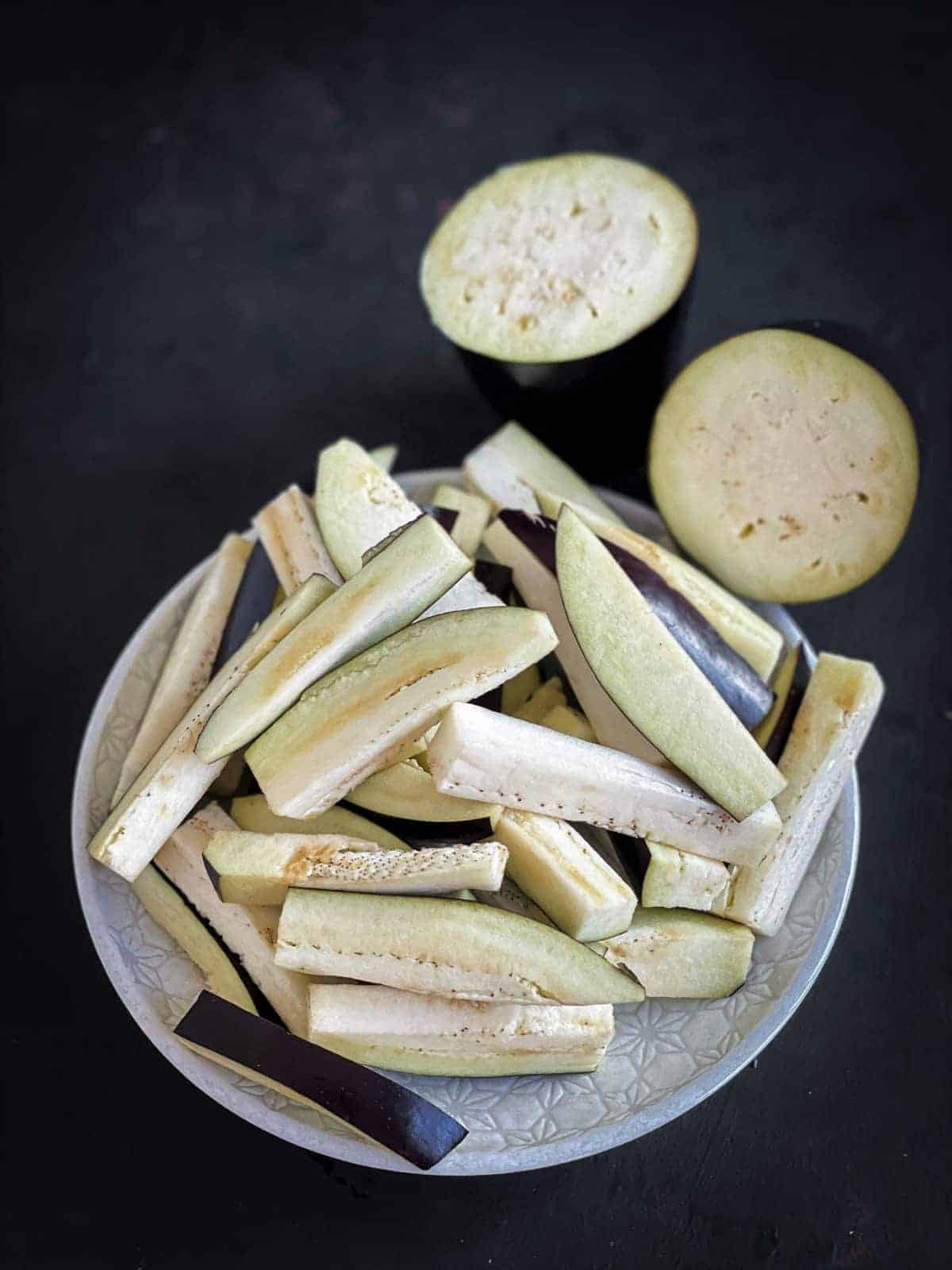
How To Steam Eggplant?
Bring a pot of water to the boil, but don’t overfill it so that it makes the vegetables wet when it’s boiling. I sliced my eggplant into small to medium-sized strips and place them in my dedicated steamer. 3 minutes and it was done!
Recipe Overview
Flavour/Texture: As eggplants are generally bland in flavour, their super absorbent flesh does well to soak up the flavours of garlic, soy sauce, sesame oil and the gochugaru. The eggplant themselves are soft without being mushy and take on an even creamier texture.
Ease: Very easy. The steaming component is literally just put in a steamer with nothing else to it. Then, prepare the other ingredients in a bowl and add the eggplant to season it. That’s it!
Time: Under 10 minutes, and you’re done. Don’t you just love that?
Ingredients
Ingredients you will need to make Korean Steamed Eggplant Side Dish – Gaji Namul.
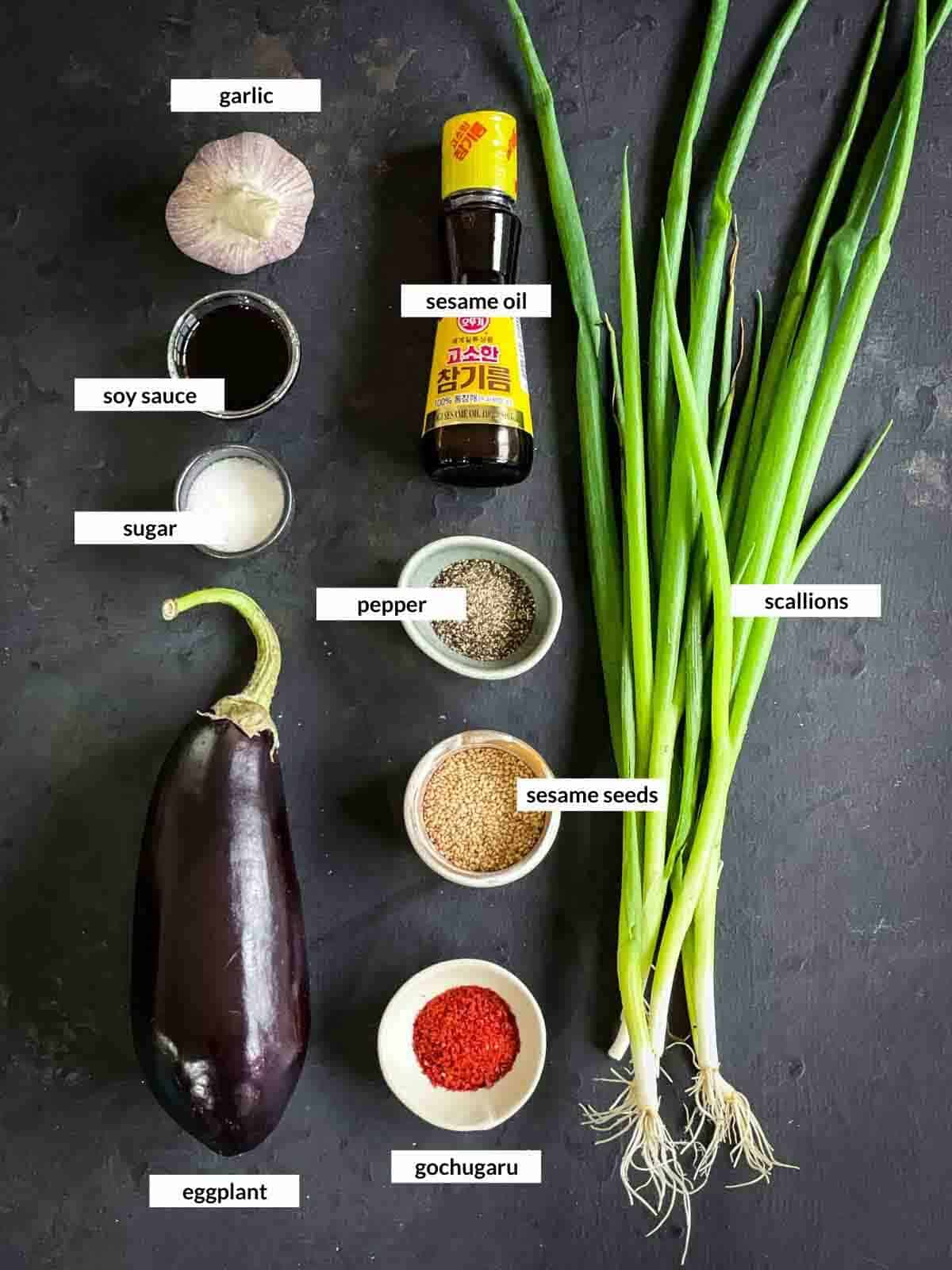
Korean eggplants or 1 globe eggplant: As mentioned above, it is best to use Korean eggplants or Asian eggplants as they are long and thin, so when you’re cutting them up, they can be cut into quarters, and each strip would have skin attached.
Absolutely nothing wrong with using the usual globe eggplants (Italian or American). It just means some strips won’t have skin on them but won’t be that many.
The traditional way of making gaji namul is that the eggplant is torn into strips by hand after steaming. But if overcooked, it would just turn into mush. Much easier to just pre-cut into strips.
Scallion or green onion: You can use either scallions or green onion for this side dish. Just try and avoid getting green onions with an overly big bulb, as it will be overpowering.
Minced garlic: Ensure the garlic is minced very well as it is folded through the steamed eggplant. You don’t want large chunks of raw garlic.
Sesame oil: Delicate Korean sesame oil would be best. You can get these in Korean supermarkets or even the Asian aisle of your regular supermarket.
Sesame seeds: Toasted sesame seeds are required. Just get the toasted sesame seeds in the plastic jar at the Korean supermarket. It will save you time having to toast the seeds yourself.
Gochugaru: A small amount of these Korean red pepper flakes are required. Gaji namul is not meant to be a very spicy dish. Just a touch to give a hint of heat.
Variations and Substitutions
No Korean eggplants: If you can’t find Korean eggplants or Asian eggplants, just select smaller globe eggplants. Try to avoid those overly massive ones, as we want more skin on the strips than none.
Scallions vs green onion: You can use either scallions or green onions. Most Korean recipes do prefer green onions, although I do find that sometimes the bulb is too big, which makes the dish overly pungent.
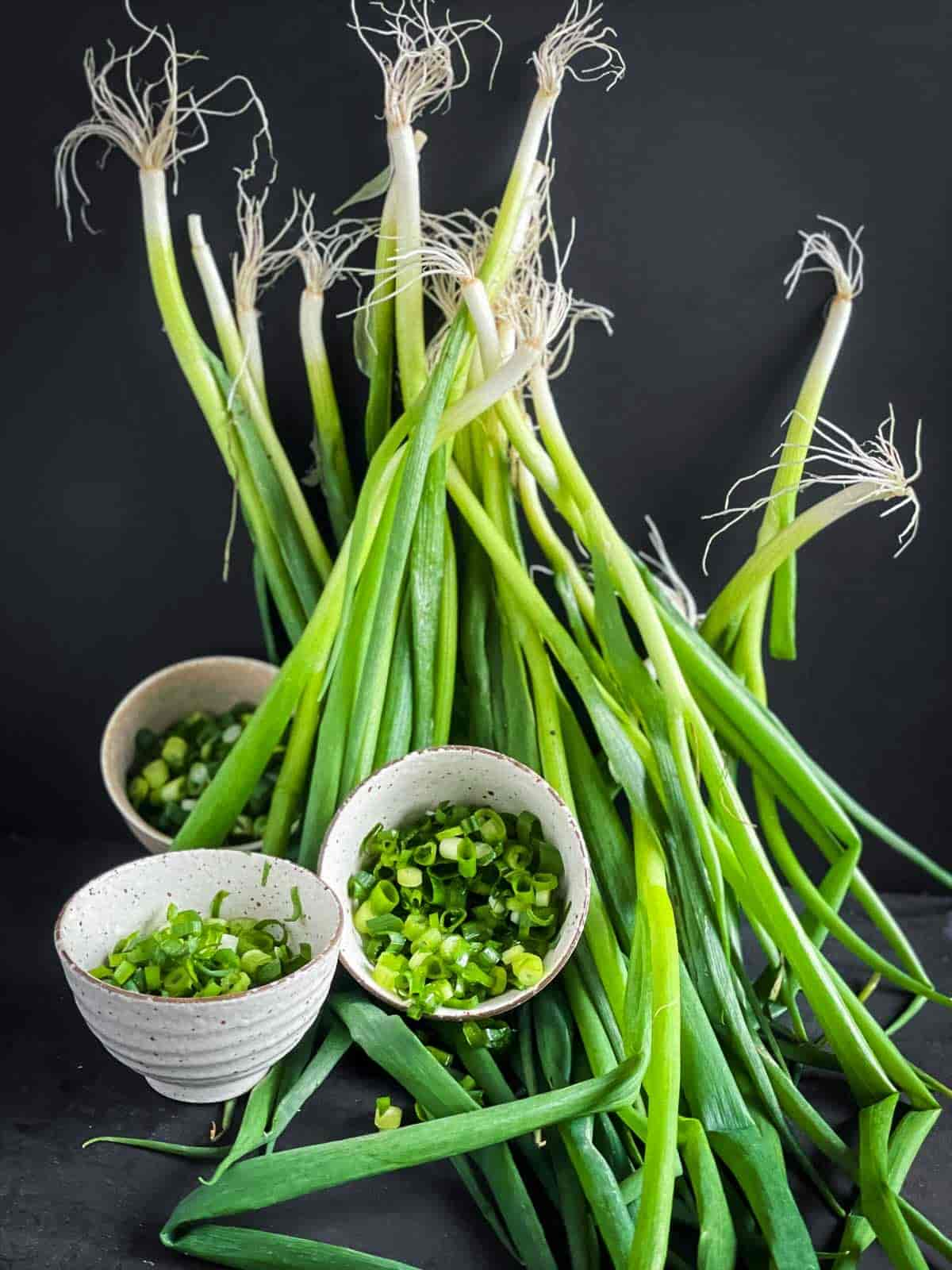
Fresh garlic v pre-made garlic: You can mince fresh garlic or get a jar of Korean minced garlic from the supermarket. Especially handy if you intend to make a whole bunch of different Korean side dishes.
Gluten free version: For a gluten free recipe, use tamari instead of soy sauce.
Gochugaru substitute: If you don’t have gochugaru or don’t wish to invest in a large bottle, you can substitute gochugaru with a mix of cayenne pepper and smoked paprika. As it is only a small amount, the taste will be ok albeit not quite the same. This is pretty close, though!
Instructions
Step by step instructions for how to make Korean Steamed Eggplant Side Dish – Gaji Namul.
Cut the eggplant 2 inches in length and if using Asian eggplant, cut them into quarters. If using other eggplants, they should be about the thickness of your index finger.
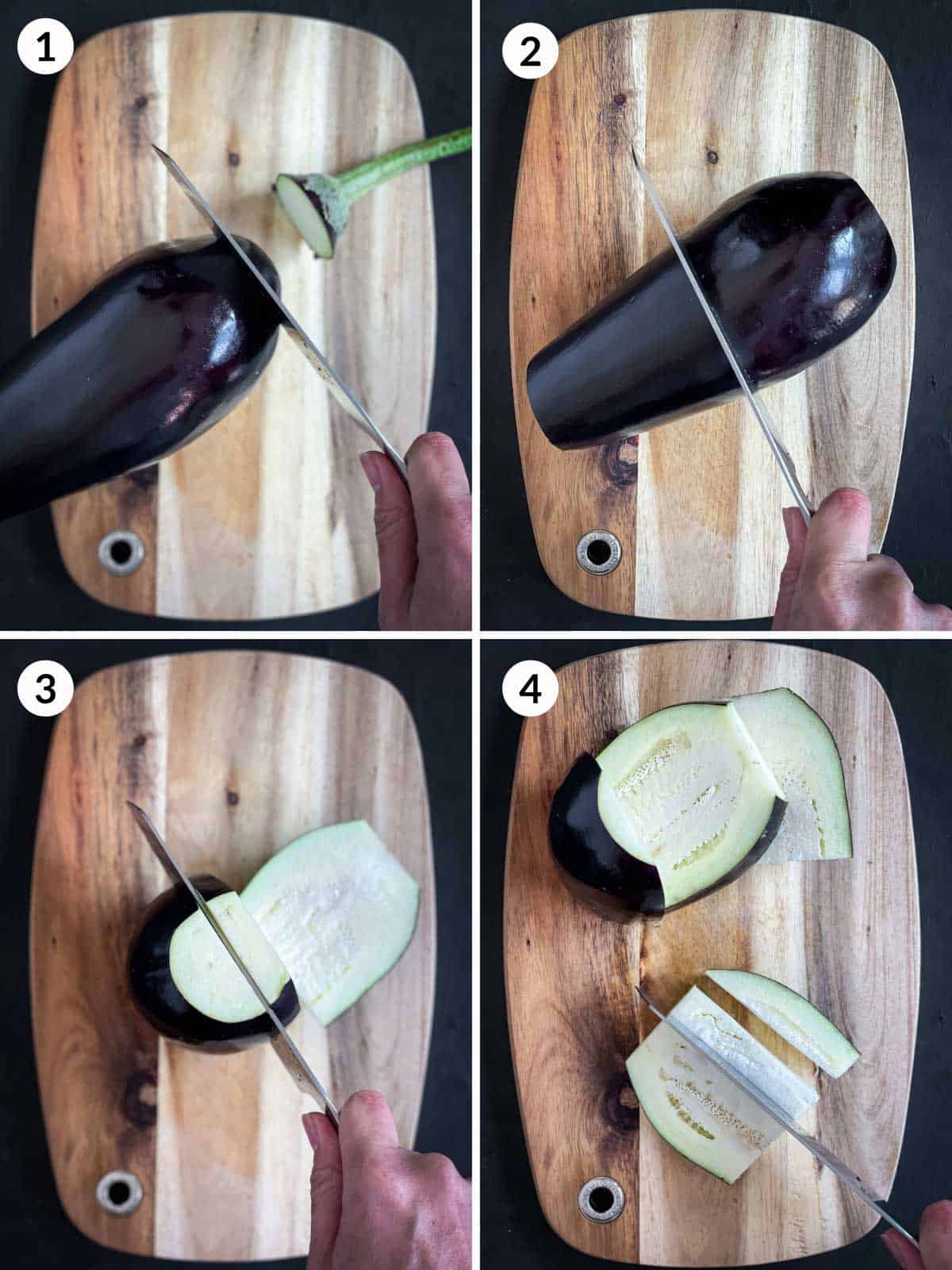
Place in a steamer and steam for 3 minutes.
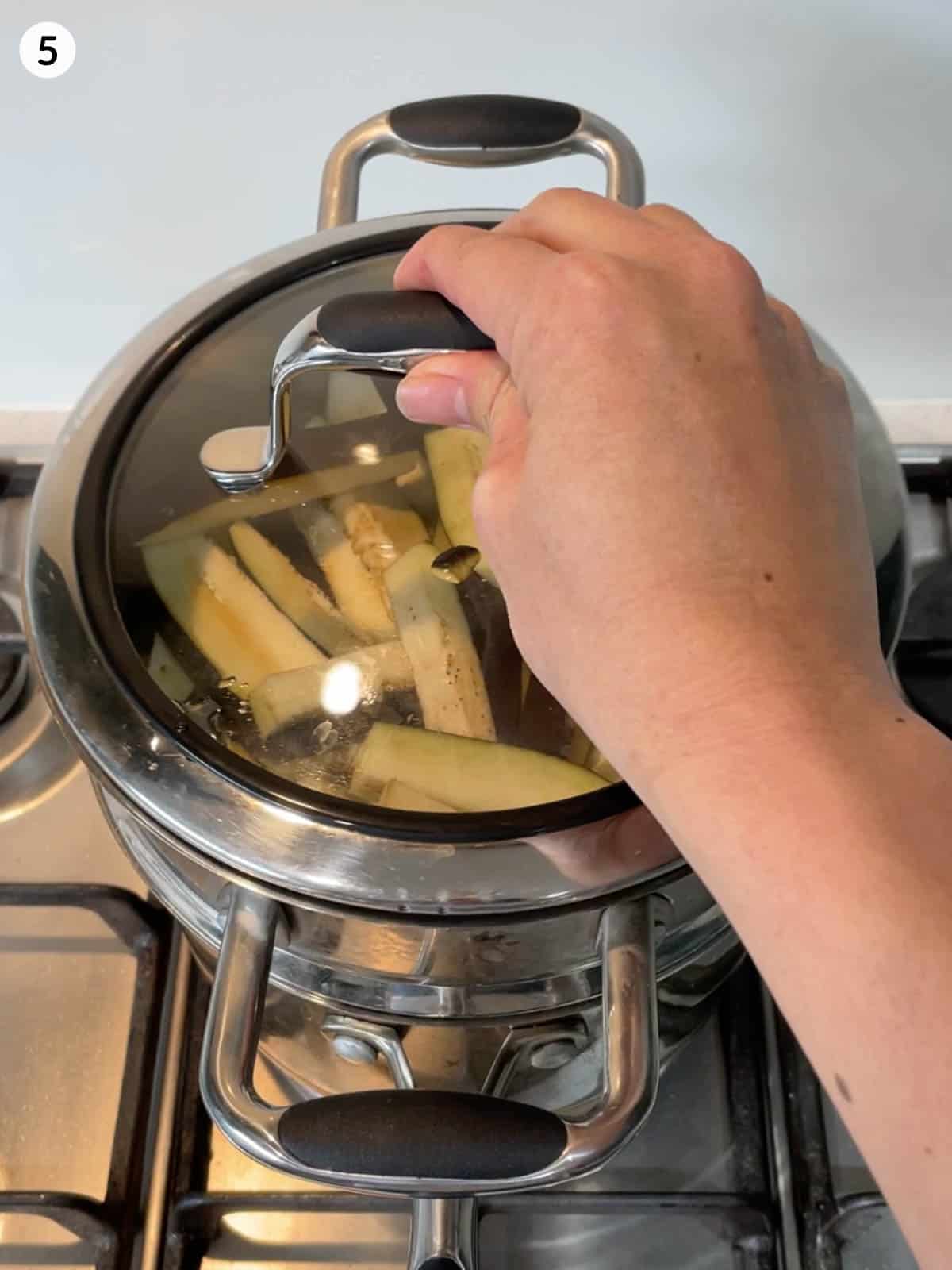
Chop the whole sprig of scallion or green onion.
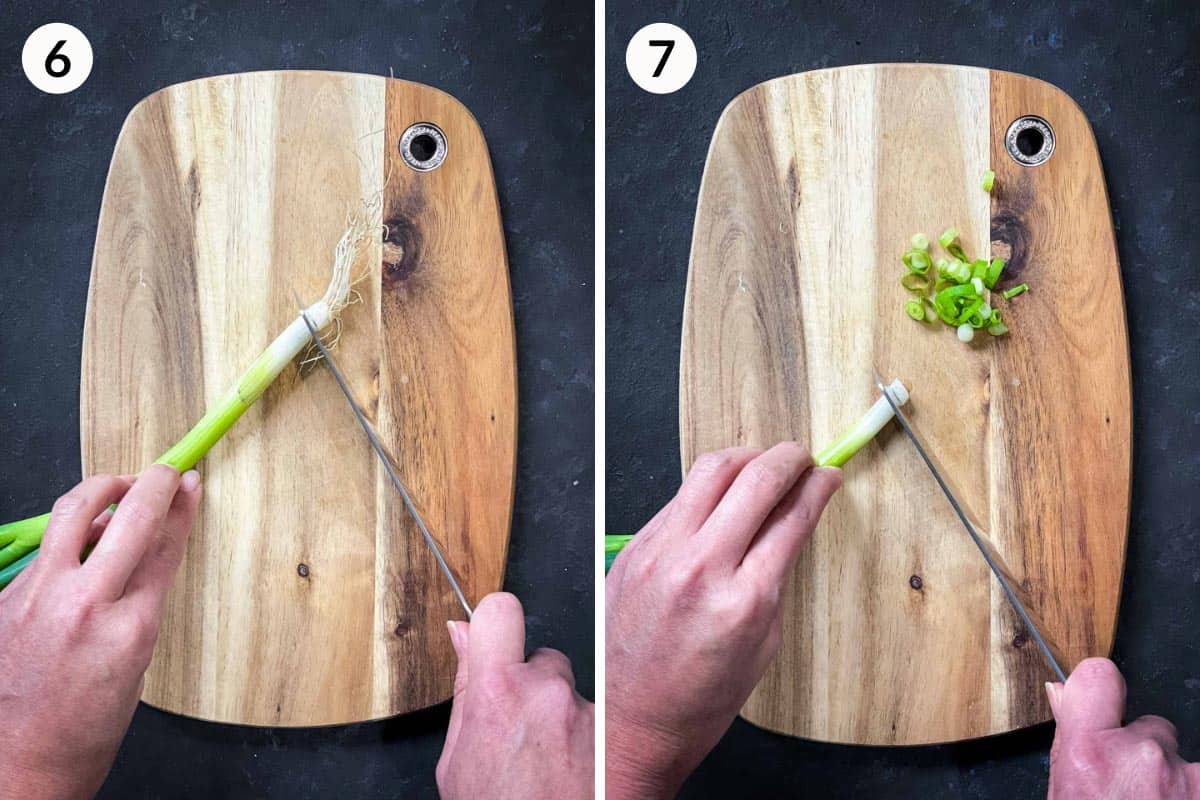
Mince enough garlic to yield 1 tsp or buy some Korean garlic mince in a jar.
In a mixing bowl, add the steamed eggplant, scallion or green onion, minced garlic, soy sauce, sesame oil, sesame seeds, gochugaru and sugar. Gently mix until well combined.
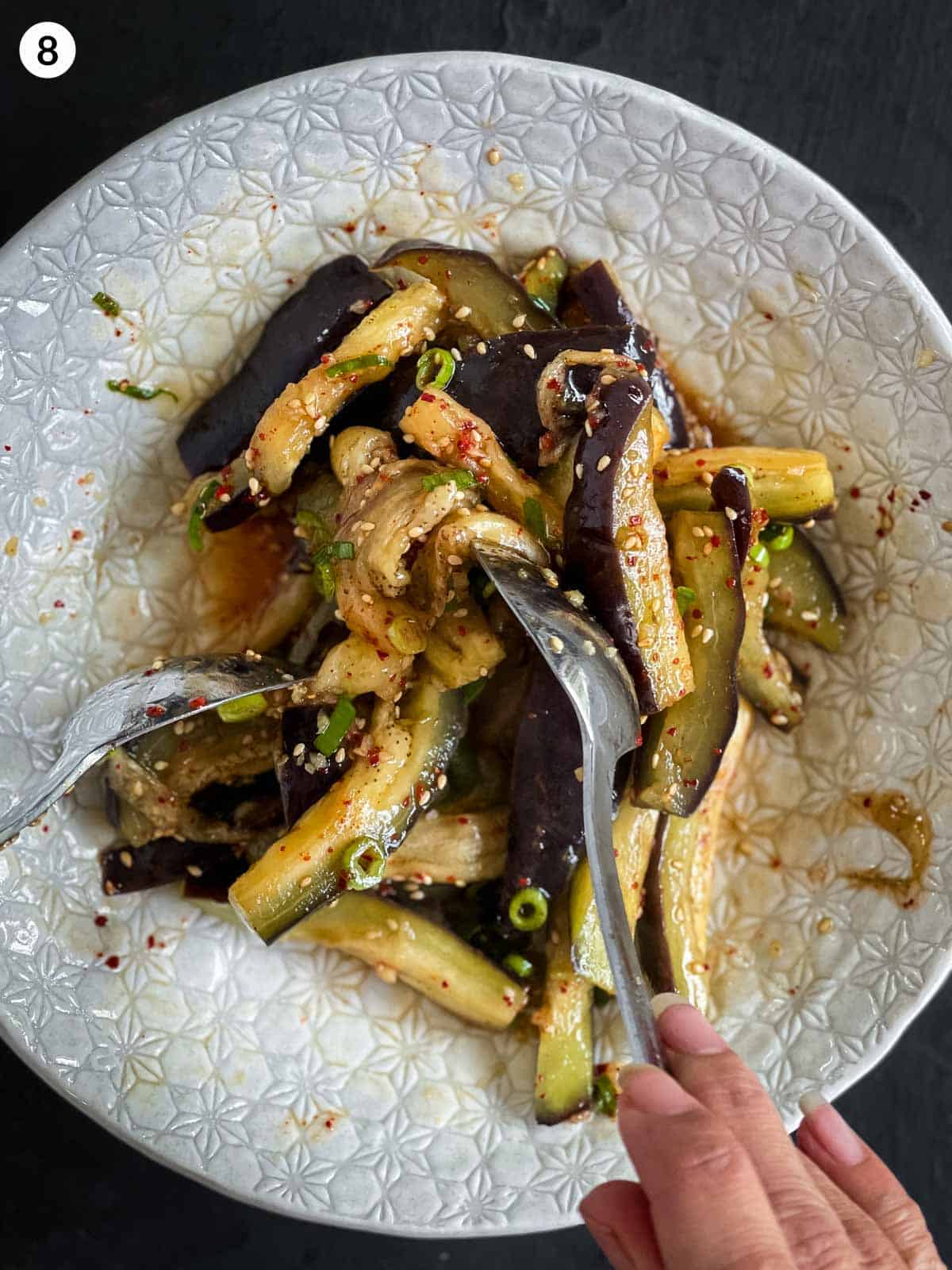
Serve.
Great Mains for This Side Dish
How to serve Korean Steamed Eggplant Side Dish – Gaji Namul? These authentic Korean dishes are some that you can make at home.
You can try this famous dish Samgyeopsal gui (grilled pork strips) that is so flavoursome. Then there is the humble Bibimbap and hot and spicy Kimchi-jjigae. If you want a feast, try them all!
Frequently Asked Questions
There is no difference apart from language. Both eggplants and brinjals are the same fruit, except that brinjal is a term used in India and some parts of Southeast Asia. The word brinjal hails from the Portuguese word for eggplant, beringela.
To make non-spicy gaji namul, omit the use of gochugaru (Korean red pepper flakes). The seasoning consists of scallions, minced garlic, light soy sauce, sesame oil, sesame seeds and a little sugar. Fold the steamed eggplant through this seasoning, and you’re done!
Gochugaru is Korean red pepper flakes. Red peppers are deseeded and then sun dried. Once dried, they are then crushed to form a consistency between a fine powder and flakes.
Modern day gochugaru is now machine dried before they are crushed and packaged for mass consumption.
Eggplant is one of those fruits which are eaten as a savoury dish. Steam eggplant is one of the quickest ways to prepare it, and it is so incredibly versatile.
The Korean seasoning is quintessential Korean flavours, and when folded through the steam eggplant, it’s a match made in heaven. A Korean side dish that you’d be able to eat all the time.
That’s all!
More Korean Side Dishes Recipes (Banchan 반찬)
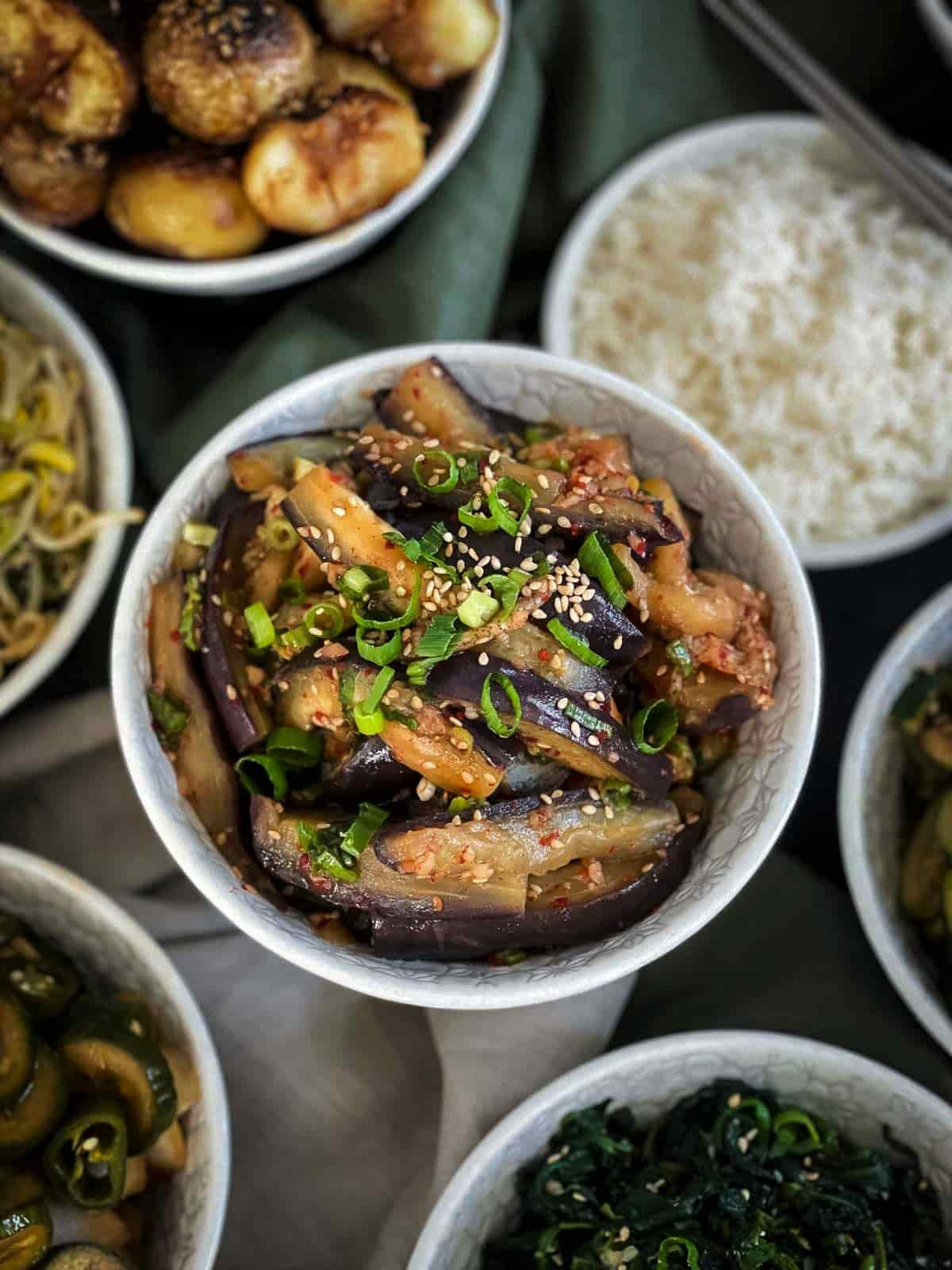
Follow us on Facebook, Pinterest, Instagram and Twitter for the latest updates!
Recipe
Korean Steamed Eggplant Side Dish – Gaji Namul
Ingredients
- 1 eggplant, Globe (or 2 Asian eggplants)
- 1 sprig scallion, (spring onion)
- 1 tsp garlic, minced
- 1 tbsp soy sauce
- 2 tsp sesame oil
- 1 tsp white sesame seeds
- ½ tsp gochugaru
- ¼ tsp sugar
- pepper, to taste
Click on the toggle below for conversion to US Cooking Units.
Instructions
- Cut the eggplant 2 inches in length.
- Place in a steamer and steam for 3 minutes.
- Chop the whole sprig of scallion (spring onion)or green onion.
- Mince enough garlic to yield 1 tsp or buy some Korean garlic mince in a jar.
- In a mixing bowl, add the steamed eggplant, scallion (spring onion) or green onion, minced garlic, soy sauce, sesame oil, sesame seeds, gochugaru and sugar. Gently mix until well combined.
- Serve.
Notes
- If you can’t find Korean eggplants or Asian eggplants, just select smaller globe eggplants. Try to avoid those overly massive ones, as we want more skin on the strips than none.
- You can use either scallions or green onions. Most Korean recipes do prefer green onions, although I do find that sometimes the bulb is too big, which makes the dish overly pungent.
- You can mince fresh garlic or get a jar of Korean minced garlic from the supermarket. Especially handy if you intend to make a whole bunch of different Korean side dishes.
- For a gluten free recipe, use tamari instead of soy sauce.
- If you don’t have gochugaru or don’t wish to invest in a large bottle, you can substitute gochugaru with a mix of cayenne pepper and smoked paprika. As it is only a small amount, the taste will be ok albeit not quite the same. This is pretty close, though!
Nutrition
*Disclaimer: Nutritional information provided is an estimate only and generated by an online calculator.
Don’t want to miss out on a recipe? Feed your FOMO and we’ll deliver it into your inbox!
Disclaimer: This site contains affiliate links to products. We may receive a commission for purchases made through these links at no additional cost to you.


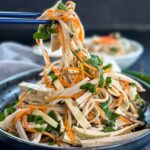



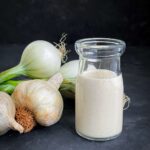







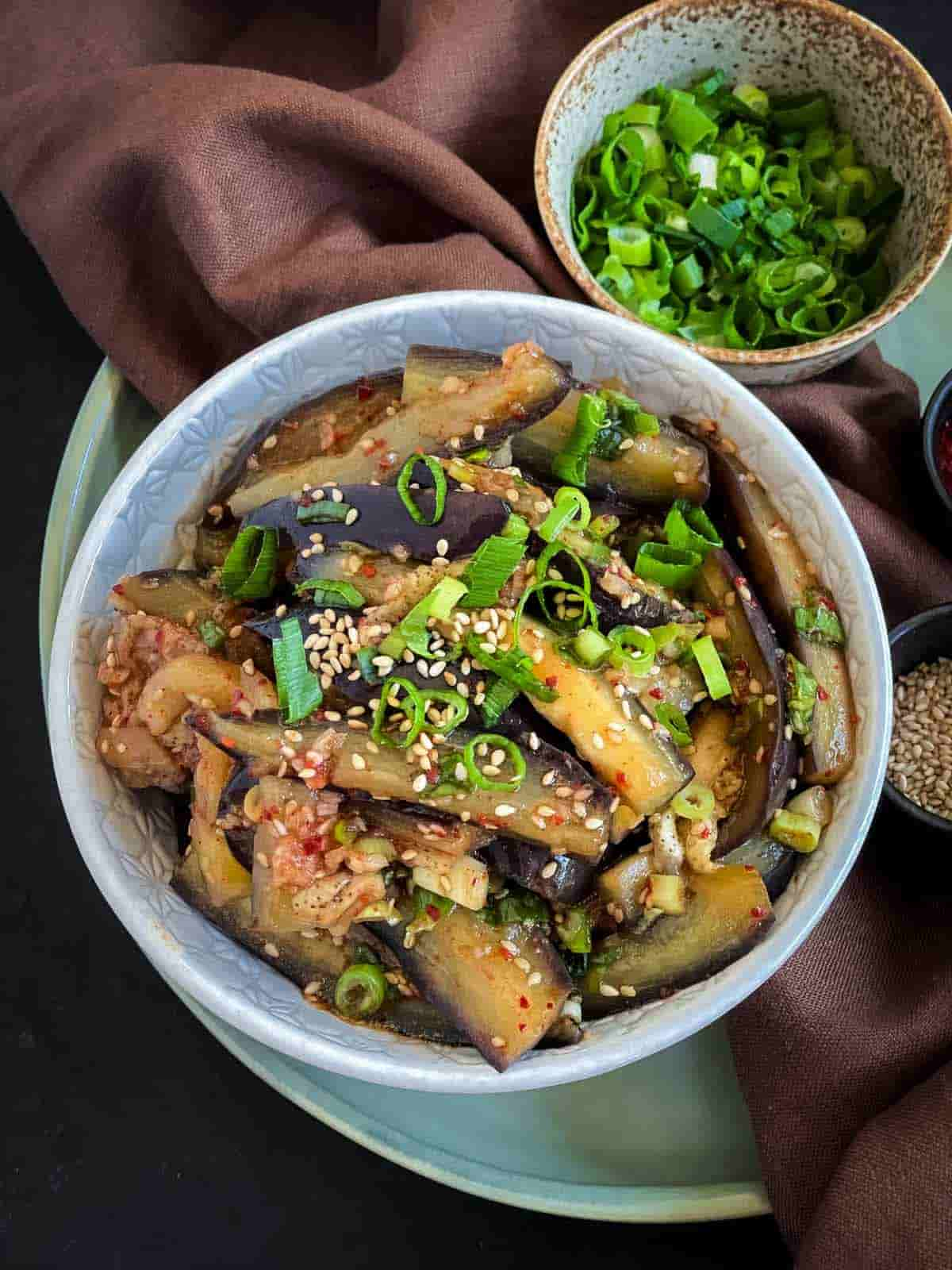
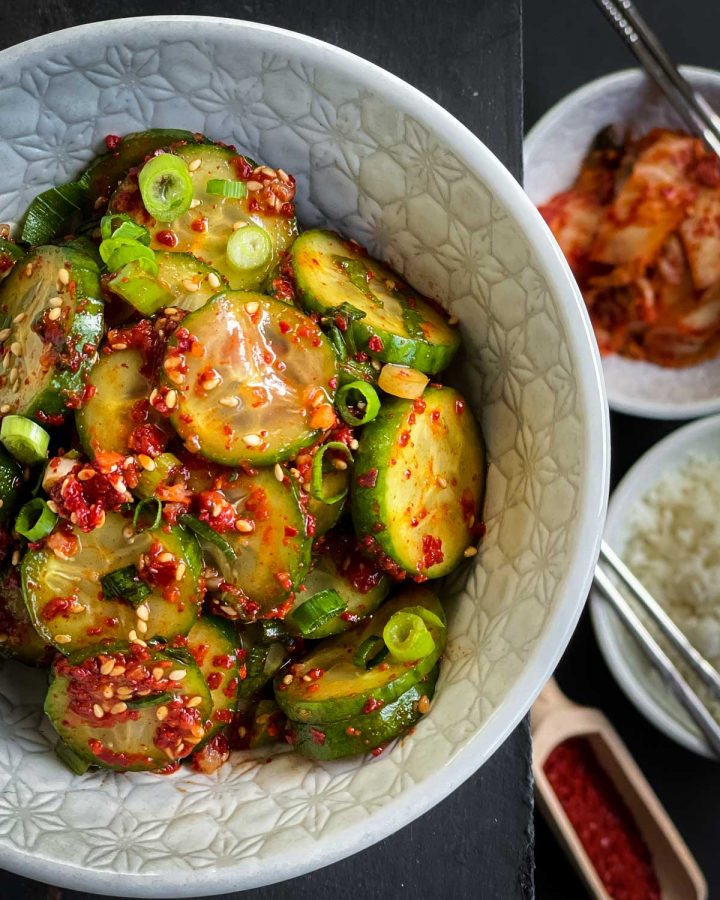
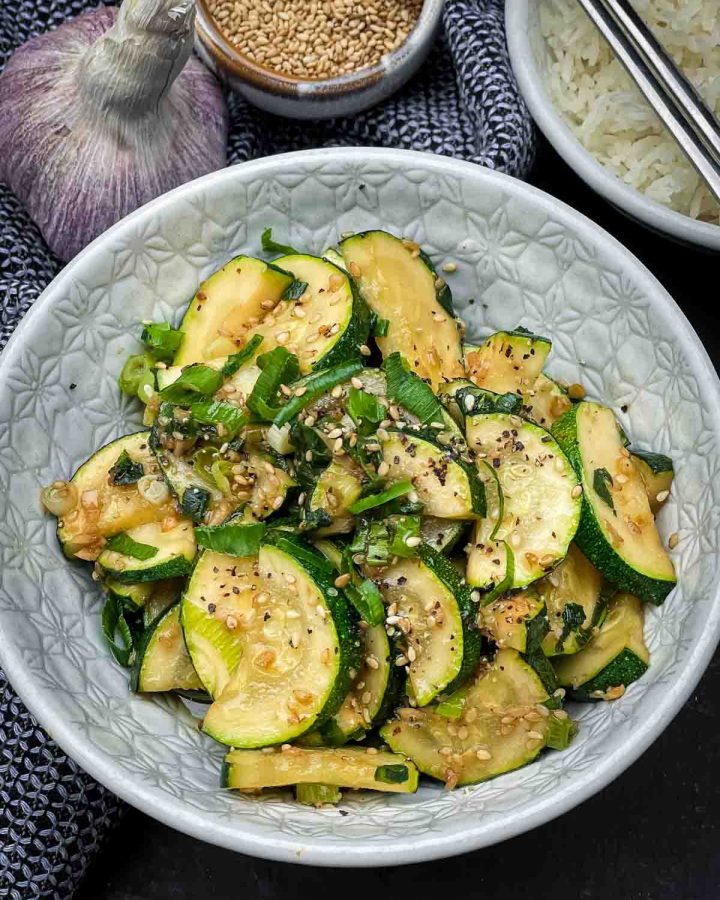
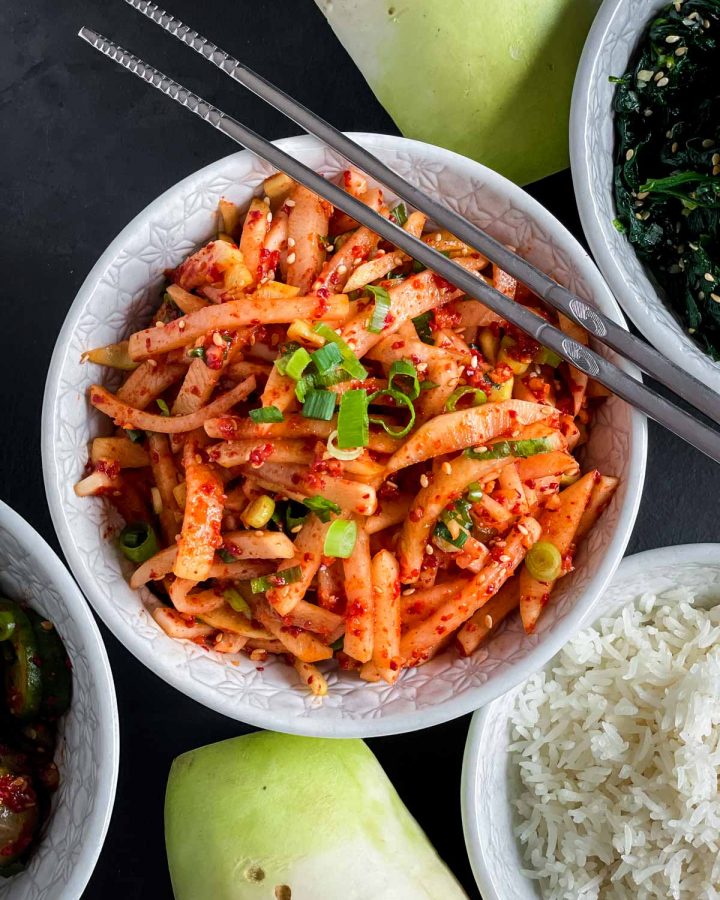
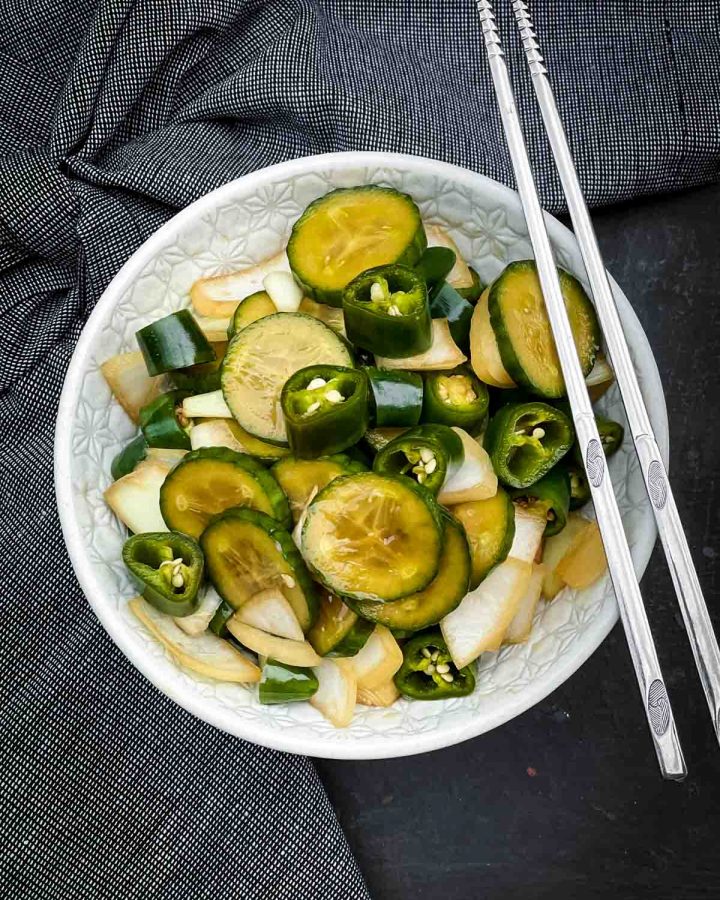
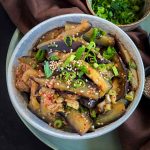
Leave a Review